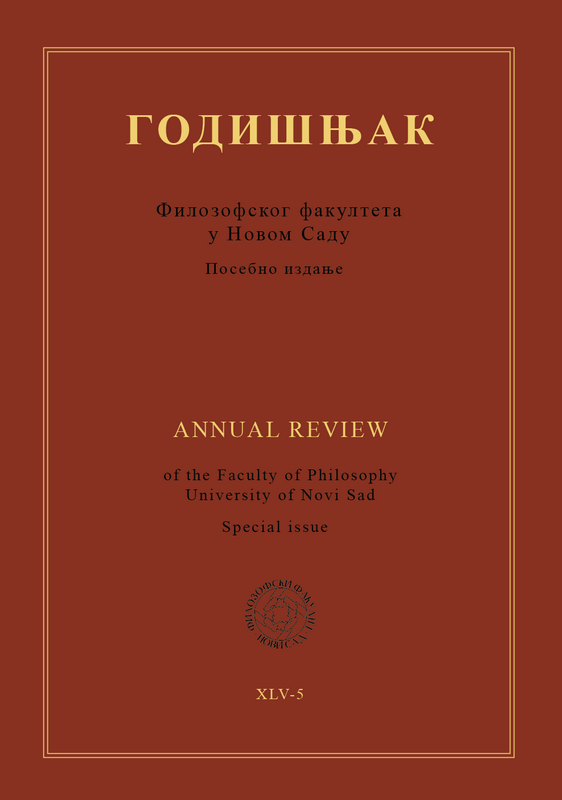BIOGRAFSKI I PROSTORNOVREMENSKI PROTOTIPOVI: „OMAŽ ŠVAJCARSKOJ“ KAO PRESJEK HEMINGVEJEVOG ŽIVOTA I AJNŠTAJNOVSKE RELATIVNOSTI
Главни садржај чланка
Сажетак
Ernest Hemingvej je opisivao tri sižejne linije u „Omažu Švajcarskoj“ kao tri „dijela“, koji sadrže upadljivo sličan prostorni okvir (stanične kafee u tri gradića) u nečemu što se čini kao isti trenutak, pošto Simplon-Orijent ekspres u svim slučajevima kasni tačno sat vremena. Pisac je bio poznat po detaljnom istraživanju građe koju je namjeravao da preoblikuje u pripovijestima i, kako tvrdi Majkl Rejnolds, namjerno je poremetio fizički poredak pojavljivanja željezničkih stanica (Terite, Montre i Vevej). Rad predlaže analizu simultanosti događajâ i njihovo nelinearno tekstualno prikazivanje sa dva metodološka gledišta. Prvo, zasnovano na Hemingvejevom priznanju da je to „nova forma za priču...“ i „to što se sva tri dijela otvaraju na isti ili praktično isti način plod je namjere“, vodi istraživanje ka autofikcionalnom prototipu koji je predstavljen u tri varijacije. Drugo pokušava da osmotri sve događaje iz relativističkog ajnštajnovskog svemira, u kome priroda posmatranih događaja zavisi od položaja posmatrača i inercionog referentnog okvira, a sve ih pokreće očekivani voz. Uticaji relativnosti ispitivani su i na osnovu dvosmislenih vremenskih referenci u tekstu, po kojima se radnja može odvijati u nekoliko različitih, ali podjednako prihvatljivih vremenskih okvira. Na sličan način, rad predlaže i to da je, ako čitalac slijedi jednostavniju auktorijalnu pripovjednu situaciju Franca Štancla, a ne složeniju figuralnu, najpristupačniji ulaz u tekst smješten u trećoj sekciji.
Downloads
Детаљи чланка
Референце
Beegel, S.F. (1992) Note to Reynolds, M. (1992), 255–256.
Biblio.com. (2014). Revolt in the Desert. Retrieved 5 July 2019, from https://www.biblio.com/revolt-in-the-desert-by-lawrence-t-e/work/17751
Collot, M. (2010). Phenomenology and Literary Experience. In: Bourne-Taylor, C. and Mildenberg, A. (2010). Phenomenology, Modernism and Beyond. Bern: Peter Lang. 319–334.
Einstein, A. (2005). Relativity: The Special and General Theory. Trans. Lawson, R., introduction by Penrose, R., commentary by Robert Geroch, with a historical essay by Cassidy, D. New York: Pi Press.
Flora, J.M. (2004). Names and Naming in Hemingway’s Short Stories. South Atlantic Review, 69, 1–8.
Fludernik, M. (2009). An Introduction to Narratology. Abingdon and New York: Routledge.
Hemingway, E. (1933). Homage to Switzerland. Scribner’s Magazine, 93, 4, 204–208.
Hemingway, E. (1981). Selected Letters 1917–1961. Baker, C. (ed.). New York: Scribner.
Hemingway, E. (1987). The Complete Short Stories. New York: Simon & Schuster.
Johnston, K.G. (1984). Hemingway and Freud: The Tip of the Iceberg. The Journal of Narrative Technique, 14, 68–73.
Lovell, C. (1976). Women and Marriage in Hemingway's Marriage Stories (Unpublished M.A. thesis). McMaster University, Hamilton, Ontario. Retrieved 14 September 2019, from https://macsphere.mcmaster.ca/bitstream/11375/9689/1/fulltext.pdf
OCTLE (Oxford Companion to Twentieth-Century Literature in English). (2004). Stringer, J (ed.) (2004). s.v. Lawrence, T.E. Oxford and New York: Oxford University Press. 381–382.
Oldsey, B. (1963). The Snows of Ernest Hemingway. Wisconsin Studies in Contemporary Literature, 4, 172–198.
Reynolds, M. (1992). “Homage to Switzerland”: Einstein’s Train Stops at Hemingway’s Station. In: Beegel, S.F. (ed.) (1992). Hemingway’s Neglected Shorter Fiction. Tuscaloosa: The University of Alabama Press. 256–262.
Steane, A.M. (2012). The Wonderful World of Relativity: A Precise Guide for the General Reader. Oxford and New York: Oxford University Press.
Sion Wine. (2014). Retrieved 27 February 2019, from https://www.wine-searcher.com/regions-sion




